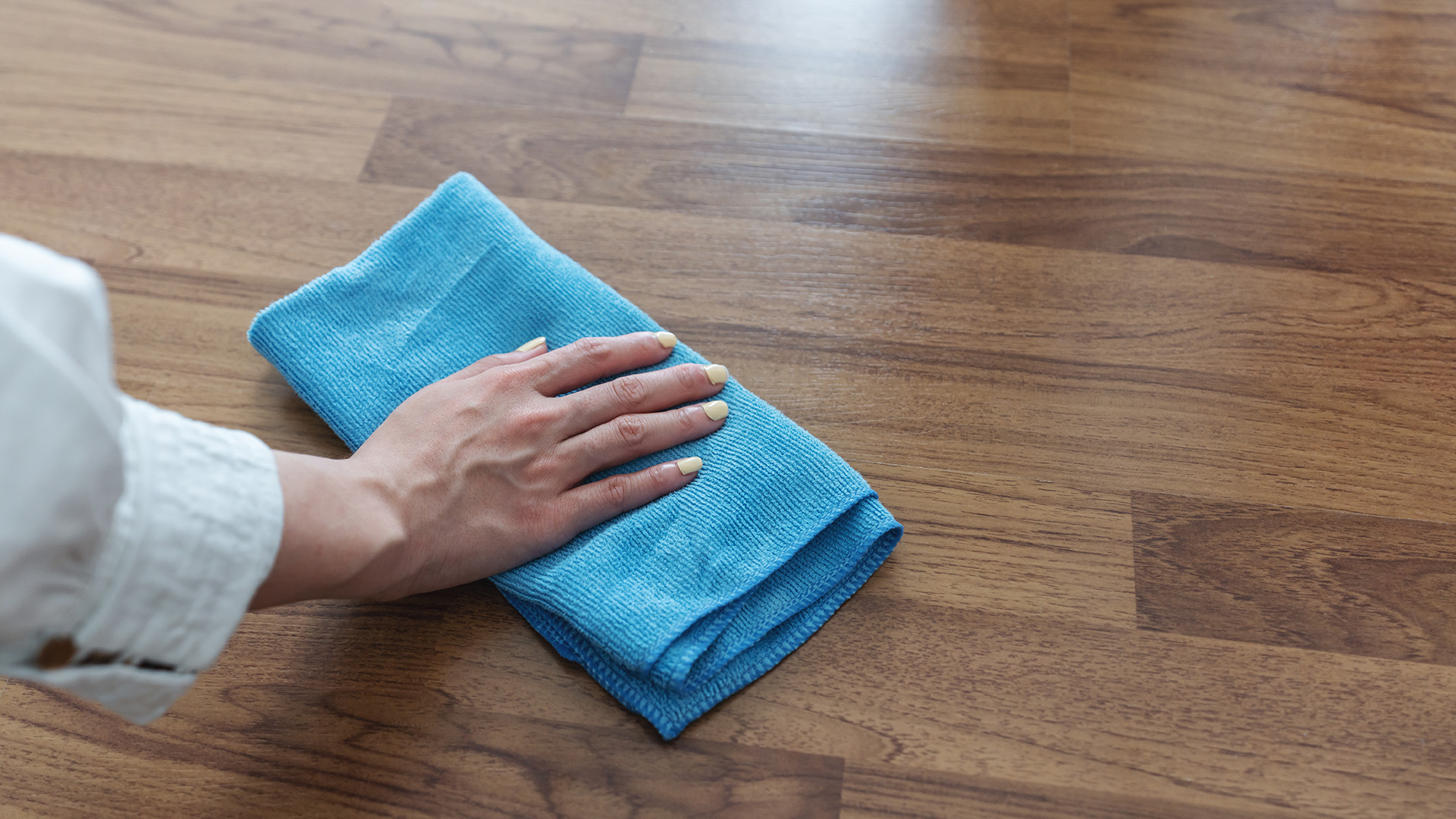
Knowing how to clean laminate floors quickly and efficiently is essential to keep your floor looking clean and shiny for years to come. Laminate flooring is generally much easier to clean than carpet or tiles, so the process can be much quicker than other surfaces. Laminate tends to be found in kitchens, hallways and bathrooms, all of which are prone to spills and muddy footprints that can make your laminate look stained or discolored if left for a long time.
If any spills or smudges occur there are some quick and easy solutions to remove them so that you don't have to worry about your floors being permanently tarnished or discolored. To make things as easy as possible we have gathered the best cleaning tips for laminate floors.
As well as a comprehensive guide, we have consulted cleaning experts for advice and tips on the topic, so that you are guided through the process with the help of people with years of experience. By eliminating any dirt or grime straight away, it will help to protect the surface of your laminate floors so that they don't get permanently damaged or lose their shine. Once you have a good cleaning routine that works for you, the process can be aided by some of the best steam mops. If you are looking to clean other areas of your house, then you might want to check out our guide to the best robot vacuums.
How often should you clean laminate floors?
Laminate Floor Expert, Carolina Hansson, says "Laminate flooring requires a little less maintenance and upkeep over time than solid wood flooring or engineered wood flooring. This is due to the thicker plastic protective layer on top."
The frequency at which you should clean laminate floors will vary depending on your household. If you have pets or children that are running around with muddy boots then you will need to clean your floors more frequently. Singles or couples may not need to do an intense clean, and can instead get away with frequent, quick, light cleaning to prevent any build-up before it becomes a problem. Any accidental spills should be taken care of straight away, especially if it's something harsh that can damage the coating of your laminate floor.
As a general rule of thumb, you should look to clean your laminate floor at least every two weeks. Even a simple wipe-down with a damp mop or cloth will help to prolong the life of your floor and keep it sparkling.
Different types of laminate floors
There are many types of laminate floors, some of which can be more difficult to clean than others. People generally choose a laminate floor based on its design and the materials that are made from. Different designs fit different interior styles, and different materials generally help when it comes to the cleaning process. Here are the most common types of laminate floors:
Plastic laminate
Plastic laminate floors are entirely artificial. They tend to be much cheaper than wood laminate and are one of the easiest types to clean. Plastic laminate is waterproof and scratchproof and is much less prone to scratches or stains - this makes it an attractive choice for kitchens and bathrooms. Plastic laminate floors are often designed to look like stone, tiles, or wood and the more expensive options do a good job of mimicking the real thing.
Wood laminate
For people who want a more traditional look but still want the easy-to-clean attributes of laminate floors, engineered wood laminate can often be a good choice. Wood laminate is often expensive, but it's commonly found in hallways and kitchens as it's very easy to clean, but could potentially tarnish over time, especially if stains are not treated immediately.
Smooth laminate
Besides the material itself, laminate flooring also comes in a variety of textures. Smooth is by far the most common and also the easiest to clean, with a damp mop often being enough to remove light dirt or soil.
Distressed laminate
Distressed laminate flooring is designed to look old. It is a relatively cheap way to get an old-fashioned aesthetic in your house, but it can be a bit of a pain to clean especially if it's a hand-scraped design.
Textured laminate
Textured laminate is often used to mimic stone, brick or tiles. It's visually one of the nicest designs but is by far the hardest to clean as you will need to physically clean the nooks and crannies which can become very laborious.
How to clean laminate floors
Carolina Hanson, Head of Design at Luxury Flooring and Furnishings says "If you have a lacquered finish laminate floor, it is pretty normal for it to lose shine over time. You can avoid this happening by mixing vinegar and water together and using a damp, soft sponge to clean the surface. Once this is done, simply wipe over with fresh, clean water to get rid of any vinegar residue. This simple and cheap technique brings back the sparkle and life of your floor."
Regular upkeep of laminate floors is important to prevent your floors from losing their shine or becoming discolored. Dust is easy to remove by simply vacuuming it, but some of the tougher stains or build-ups will require more care. It is especially important to keep laminate floors clean in areas such as kitchens or bathrooms, as these areas need to be germ-free to maintain a healthy lifestyle.
Ideally, you should look to vacuum your laminate weekly, as too much dust can severely hinder the cleaning process and can also reduce the effectiveness of your mops or sponges. It is also very important to actually identify what your laminate is made from, as some designs or materials may require extra attention, especially if it is textured or tiled.
1. Remove any dust
Firstly, you will want to vacuum or sweep your laminate floors to remove as much dirt, dust or loose leaves as possible. If you are sweeping it, make sure to use a brush with soft bristles to avoid any scratching or damage to the surface. This step is essential to prevent any gunky build-up on your floor after using water.
2. Wash the floors
Use a lightly damp microfiber mop. Laminate flooring is naturally water-resistant, but excess moisture can damage the boards causing bubbling or delamination. A solution of warm water and washing-up liquid will help to remove any dirt or residue that has dried onto your floors. A soft, microfiber cloth or mop will prevent any scratching and is a great way to kickstart the cleaning process. To avoid streaks, always mop along the grain.
3. Dry it down
After mopping, it is important to dry the surface - especially if you have hard water. You can dry your laminate with a soft, dry cloth or a dry mop. Leaving water on your laminate for too long can cause it to bubble, so it's important to dry it immediately. If you have soft water and your floor is only slightly damp, then opening a window and letting it air dry will do the job.
If your laminate is heavily soiled, or if something nasty has dried up on it then you can use the exact same solution, but replace a mop with a cloth and give it a good scrub. We would recommend focusing on heavily soiled areas before doing a general clean for the best results.
What not to use to clean laminate floors
There are some tools and cleaning solutions that can cause permanent damage to your laminate floors. Avoid using any of these to keep your floors in good condition:
Bleach
Bleach is too harsh and can cause irreversible damage to your laminate floor, even if it is heavily diluted. It is way too abrasive, and water and a basic cleaning solution will do the job just as effectively.
Ammonia
Much like bleach, ammonia is too abrasive and can permanently strip your laminate floor of its shine. Laminate floors are very durable, but ammonia will strip the protective layer off even if it's diluted in water.
Acetone
Acetone can delaminate your laminate floor by removing the protective layer on top. Steer clear of it.
Too much water or hot water
If you use hot water, or large quantities of water then your laminate floor can bubble or become misshapen. To avoid this, use small quantities of warm water and don't let it sit on the floor for too long.
Abrasive tools
Any abrasive tools such as wire brushes or hard, plastic brushes should not be used. They can strip the floor of its protective layer, and can even scratch the laminate floors ruining their look entirely.
Any cleaning products that aren't laminate friendly
This one is quite obvious, but any cleaning products, especially floor cleaners, that don't explicitly say they are suitable for laminate should be avoided.
How to protect laminate floors from damage
One of the best ways to protect laminate floors from damage is by correctly cleaning them as per the steps above. Avoid any harsh chemicals, and avoid tools that could scratch or gouge your floors. One of the most simple ways to protect your floors from discoloration is by frequently cleaning them correctly to remove any dirt or grime before it has a chance to penetrate the floors and cause damage.
It's also important to remove your shoes before walking on laminate floors, as any stones or dirt stuck in the soles could potentially scratch or damage the floor. High heels and other hard shoes could also leave scratches or dents, so consider leaving them at the door.
Discover more guides for the home…
Best robot vacuums
Best deep clean vacuums
Best handheld vacuums
Best carpet cleaners







